← Back
Lost Glider at sea found thanks to Argos and Goniometer
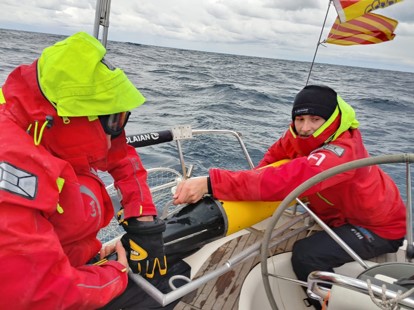
Gliders are valuable platforms in terms of equipment but also in terms of the vital information they collect. It is therefore not surprising that many of them are equipped with small Argos beacons in order to recover them in case of loss at sea. Currently, these Argos beacons rely on 8 satellites orbiting the earth, but by 2023, +25 KINEIS nano-satellites will complete this constellation and offer a 15-minute revisit time and bi-directional capabilities to allow gliders to stay connected at all times.
A glider is an autonomous underwater drone used to monitor the oceans by taking measurements such as temperature, conductivity, currents or ambient noise. Until now, small Argos beacons have proven to be very useful to recover gliders thanks to their technology and the Argos satellites that “listen” to them constantly.
This is exactly how the glider SEA017 belonging to ALSEAMAR was recovered in November 2020, with a lot of perseverance and the help of the goniometer.
Glider SEA017
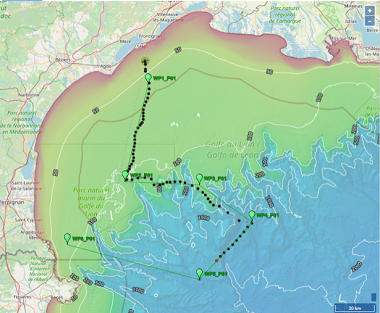
Glider trajectory at the beginning
ALSEAMAR is a well-known French glider manufacturer, but they also regularly conduct searches with at least 1 or 2 gliders at sea all year long. The mission of SEA017 was to monitor the noise pollution in the Mediterranean basin, in particular in the Gulf of Lyon.
After 11 days at sea, a trip of 160 km and some minor alerts indicating a problem with the linear engine, SEA017 was approaching the end of its mission. Suddenly, the communication with Iridium stopped on November 14, but the researchers were still receiving some sporadic Argos signals. The research team began to plan the rescue mission.
Preparing the rescue mission
CLS experts worked closely with ALSEAMAR to prepare the rescue mission. To obtain as much information as possible from the Argos messages, a multi-pass location was calculated. This location can be calculated when very few messages are received from a beacon by using the messages collected during several satellite passes.
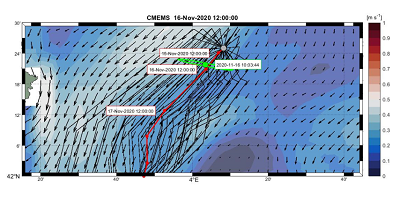
Drift models
At the same time, with the last Iridium communication of November 14, drift models were used to try to predict the trajectory of the glider. One of the possible trajectories corresponded to an Argos position of November 16. However, a new Argos position was calculated on the 17th and it no longer matched the drift model: the situation became critical.
In order to focus the search efforts, the team used a tool to provide search areas based on the drift models and estimated positions at the time of the rescue mission.
Rescue mission
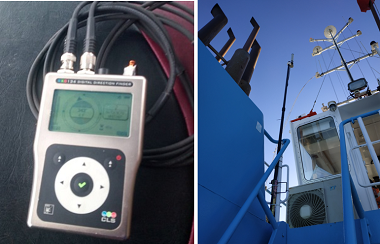
Goniometer on the boat
Once the team decided where to search, they installed their CLS goniometer on their search vessel and loaded a glider and SeaExplorer radio. Arriving in the last known area, they received a few pings with Argos, but it was getting dark, and the glider wasn’t blinking as they had hoped.
As the weather conditions deteriorated, the boat captain decided to return to land, forcing the team to abandon the glider.
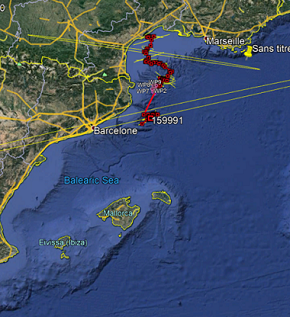
New Argos position
It’s not over yet
A few days later, after an absence of communication, the weather conditions improved and the Argos beacon started transmitting again: the glider was on its way to Africa.
With these new positions, a new rescue mission was launched in Barcelona, this time with a drone, the goniometer and a sailing boat.
Thanks to the recent Argos positions, the goniometer was able to find the glider almost completely submerged.
After 19 days of drifting in the ocean and 2 rescue missions, SEA017 and its invaluable data have been saved.
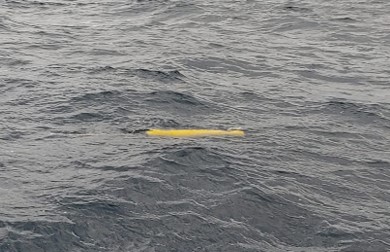
Submerged glider found with the goniometer
According to Laurent Beguery of ALSEAMAR who led the rescue missions, “It was several things that saved the glider, first of all our perseverance and dedication, the gonio and the wet/dry sensor of the beacon that sends a signal as soon as it detects that it is out of the water”.
Following your experience, I guess you must be happy with the arrival of the 25 KINEIS nanosatellites in the ARGOS constellation and the better revisit time they will allow?
“Indeed, but I hope I won’t have to lose a glider to try it”

